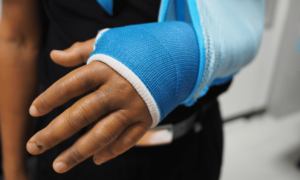 One of the most common reported orthopedic injuries are fractures with nearly 6 million people falling victim of a broken bone. Our bones are strong, yes, however when we overexert ourselves there is possibility for the bones to crack or in extreme circumstances like in auto accidents they can completely shatter.
One of the most common reported orthopedic injuries are fractures with nearly 6 million people falling victim of a broken bone. Our bones are strong, yes, however when we overexert ourselves there is possibility for the bones to crack or in extreme circumstances like in auto accidents they can completely shatter.
When A Bone Breaks or Fractures
Every bone has it’s breaking point and those bones that are reported fractured the most commonly is the clavicle or collarbone which is reported at 5 percent of most breaks. This bone connects your shoulder blade to your rib cage and its located in a vulnerable spot and combined with its slender shape leaves this bone open for an easy break. Those who may fall or even over stretch can find themselves with a fracture.
When you suspect a break, your physician will require an X-ray to determine if a fracture has occurred and in some cases even a CT scan. A grinding or cracking or even bruising may be present and signs of a fracture when trying to move the injured bone.
The clavicle, when fractured, is typically noticeable right away but other bones may not be as clear to diagnose to the naked eye. With the arms and ankles which are common areas for fractures, one may not be able to determine if it is a break or sprain and swelling and bruising are common for both.
When pain is found around the soft tissue area in the tendons and ligaments this is often a sign of a sprain. When there is sharp pain around a bone or difficulty walking or applying weight to the limb this is often a sure sign of a break.
Bones in the arm like the ulna, radius and humerus are the most common fractures found in the arm. These fractures typically occur as a result of a fall or overstretching the arm. In regards to children they are most susceptible to forearm fractures and account for nearly 40 percent of all pediatric breaks. Contacting a physician if a break is suspected is crucial especially in children as the breaks may not heal properly.
Within the elderly population, hip fractures are often most common. As you age, your bones become more brittle and put you at risk for developing a condition called osteoporosis which ultimately lead to porous bones leaving those more open for fractures. As you age your vision and balance may decrease leading to falls.
How To Treat A Bone Fracture
If a fracture is suspected, use the RICE technique (rest,ice,compression,elevate). It’s vital for someone who suspects a break to seek medical attention immediately to avoid more damage done to the bone or soft tissue.
If you have suffered a fracture and would like to learn more about how to manage your pain, contact our Jonesboro accident chiropractors for a consultation today! Dial (404) 602-0387 today to get started on effectively managing your pain!
